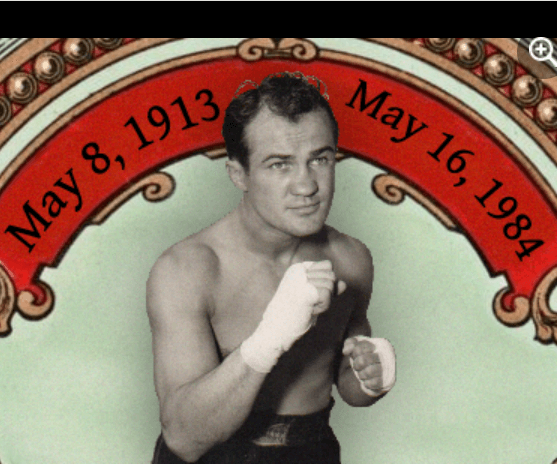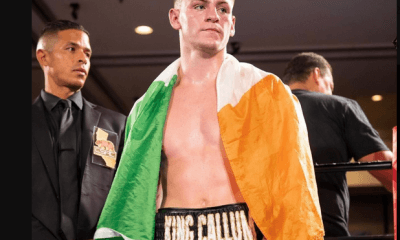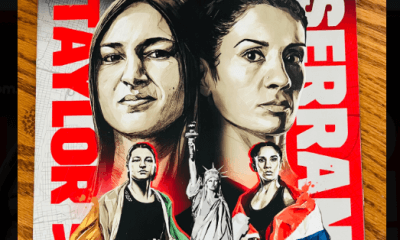Featured Articles
A Pearl from the Boxing Vault: Fritzie Zivic Will See You Now

“He was a great teacher,” said Billy Conn. “[Fighting Zivic] was like going to college for five years, just boxing him ten rounds…”
Fritzie Zivic never asked why. He never asked if his opponent hit hard, if his opponent deserved the shot, if the opponent would be tough. He just said “yes” and signed the contract. While [Jake] LaMotta, who somehow gained the reputation for fearlessness of which Zivic was more deserving, was asked about Charley Burley, he is supposed to have muttered “Why do I need Burley when I have Zivic?” Zivic, of course, stepped out of his weight class to lose an under-celebrated series with LaMotta, and was one of the few top white contenders to ever meet the avoided Burley.
Perhaps this fearlessness is the reason why Zivic may have fought a better array of boxers than any fighter in history. In addition to the multiple contests with LaMotta and Burley, he met Kid Azteca, Bob Montgomery, Beau Jack, Henry Armstrong, Freddie Cochrane, Lew Jenkins, Izzy Jannazzo, Phil Furr, Bummy Davis, Sammy Angott, Lou Ambers and Jimmy Leto, something very close to a “who’s who” of boxing’s golden age, and he met most of them more than once. He didn’t always win, but he always gave his all and for this the people and the promoters of his hometown of Pittsburgh and beyond loved him. Other fighters? Not so much.
“He’s the dirtiest fighter I ever met,” claimed Charley Burley after his disputed points loss in their first fight. “He thumbed me over and over again.”
“When you fight for a living,” Zivic would explain years later, “if you’re smart you fight with every trick you know. If I hadn’t known nine zillion of them I never could have won the welterweight title from Henry Armstrong.”
In the modern era, fighters can come to a title without even matching a top contender. Forty fights is a career. But in the 1940s, it was unusual to see a champion with so few fights, even a young one. Like other trades, to reach the top of the heap a fighter had to become a master craftsman, the tools at his disposal needed to be of the highest quality. To this end, fighters needed to be matched often or tough or both. But there were and are some fighters who can provide a special lesson to that prospect or contender, a boxing lesson that, win or lose, crystallizes the nature of the sport for the man in the opposite corner.
Fritzie Zivic was such a fighter. Unquestionably world class in his own right, Zivic was a quick learner who took his “zillion tricks” and applied them to roughhouse boxing that tested every corner of his opponent, technical, physical and mental. Anybody that beat him looked destined for the top, anyone that lost could still pick up more than a thing or two. Unquestionably teak-tough, a stinging if not prohibitive puncher, he could box inside or out and a tight defense and iron chin kept him to two legitimate stoppage losses in a 232-fight career. But unquestionably, Zivic’s greatest strength were his smarts, the tricks, traps and roughhouse tactics he absorbed like a sponge during his eighteen years in the ring.
In December of 1936, Zivic would teach some of these tricks to a wonder-kid tearing his way up the middleweight division, one Billy Conn. Zivic was not yet in his own absolute prime but he was twenty-three and listed as a veteran of some sixty-eight fights. Still a teenager, Conn would at least have had bulk to fall back on as a substitute for experience, weighing some seven pounds heavier on fight night at just under 157lbs.
Zivic started fast, attacking with both hands and Conn allowed him his way, trying to outbox and outpunch the smaller man in the pocket. This had become Billy’s habit, fighting, as he did, in a fan-friendly manner that had made him Pittsburgh’s favorite prospect. He had been in a desperately close series with resident local tough and brutal infighter “Honey Boy” Jones. According to some, Conn had been lucky to emerge from their third fight with a decision, his inability to adapt costing him dear in points and punches. Now Zivic fought in a style intent on taking advantage of the same flaws Jones had partially exposed, and Billy was paying for it in blood.
“Through two torrid rounds,” wrote Regis Welsh for The Pittsburgh Press, “Fritzie belted Conn to a fare-thee-well, but never quite touched the vital spot. At the end of the second…[Conn] was smeared with blood from a cut on his left cheek and a badly battered mouth.”
The press hadn’t yet been enlightened to Conn’s iron chin and it’s quite possible that Fritzie had found the “vital spot” over and again throughout the fight. As time would tell, even history’s mightiest puncher would struggle to get over on the near invulnerable Conn. However, at the beginning of the third Billy looked “tired, weary and worn out” and “in the fourth and fifth, Zivic, in a rushing charge, bore Conn to neutral ropes and belted him about the head and body until it seemed that the anticipated kayo was inevitable.”
It needs to be said though, that in spite of his fighting the wrong fight, Conn was doing his own good work, mainly to the body. Some reports credit Conn with turning the fight with a body punch as early as the third, but whilst the supposed fight of two halves (Zivic winning the first five, Conn coming back in the second half of the fight) did not occur, it’s unlikely that Conn’s hooks had the supposed affect this early. Only two judges scored the third for Conn, and all three gave Zivic the fourth. Conn wouldn’t win a round on all three judges’ scorecards until the sixth.
It was in the sixth round that Conn cracked, and went outside. In the seventh and eighth Conn “boxed beautifully…he danced, feinted, pranced and punched.” Zivic, now out of his element as a bullying counterpuncher and destructive infighter struggled to get past Billy’s “piston-like” jab. Conn had been trained for this by defensive specialist Johnny Ray from the very beginning, but he had been unable to make the transition in the ring until Fritzie had forced it. As one would expect, Zivic now changed tactics too, gunning almost exclusively for the body, only hunting Conn with power punches, bringing him the eighth round on one card. In the tenth, they went at it toe-to-toe again. “The boys used everything but knives,” stated the Pittsburgh Post-Gazette. “A wild-eyed crowd looked on.” The final round was shared on the three official cards resulting in a split decision win for Conn (6-3-1, 5-4-1, 4-5-1).
“From a mile in the rear to a nose in front takes heart in a man or a horse,” wrote Welsh in The Press. “Particularly in a novice of Conn’s immature ring experience against a seasoned veteran of Zivic’s type.”
Zivic’s type indeed! Fritzie was hell on wheels for a young fighter, one that hadn’t seen a top class cutie, never mind a back-alley wizard. But Conn knew what that fight had been worth, and he knew he was the better for it.
“He was a great teacher. [Fighting Zivic] was like going to college for five years, just boxing him ten rounds…I learned a lot in that fight. He’s a tough fighter, but I believe I’m just as tough.”
It’s a double lesson for a relative novice like Conn. First, he remembers every foul, every slither out of sight of the referee, every feint that cost him a round, every dig inside on the break. But it also teaches him that he can take it, that he can get in there with world-class fighters who know more than him and beat them. The first lesson is priceless, but the second can be the key to a career. Over the next twelve months the young Conn, who had struggled so desperately with Honey Boy Jones only three months earlier, would defeat great champions and ring legends such as Teddy Yarosz, Young Corbett III and Vince Dundee before adding Fred Apostoli and Solly Krieger and annexing the world’s light heavyweight title in 1939.
In 1941 he would be matched with the great Joe Louis. It would be unfair to Conn’s great trainer Ray, and to Conn himself, to lay too much credit for Conn’s legendary performance at Zivic’s door, but Conn’s tactics against Louis—mixing careful, punch-picking infighting with beautiful movement and judge of distance on the outside—were basically a more perfect version of the tactics he used in rounds six, seven, eight and nine against Zivic.
As for the teacher, he was naturally disappointed and was keen on a rematch, but fate was to intervene. Zivic would contract pneumonia the following summer whilst training for a match with Vince Dundee.
Chet Smith, then editor of The Pittsburgh Press: “There didn’t seem to be a chance for him…so we collected all we knew about him, wrote it into a story and sent it to the composing room…There were two weeks when it was touch and go with Fritzie, and the hospital folk refused to give out a single cheerful bulletin. We knew of course when he finally came out of the hospital that his boxing days were ended.”
I guess Zivic would have snorted at that. However they build them out in Zivic’s ancestral Croatia, they build them tough because Zivic was not only far from ended as a boxer, he would get better. There were more lessons to give out. The greatest fighter that would ever draw breath, he needed a lesson.
“I learned more in these two fights with Zivic than in all my other fights put together!”
So said Ray Robinson after pulling off the extraordinary feat of stopping Zivic in January of 1942. But this was the second time Zivic, a rarity in that he never discriminated against opposition on the grounds of colour or quality, had met Robinson. The first had occurred when Zivic had already slipped past his absolute prime, in October of 1941.
“It might have been a draw. It was close,” wrote the correspondent for The Telegraph Herald, but Zivic, the heavier man for a change, looked unsurprised at the unanimous decision against him. In the middle rounds he had, to a degree, had his way with Robinson but Sugar’s explosive domination of the ninth had left him struggling and at no time had he solved the Robinson jab. He knew he was beaten. “[Robinson] took a unanimous decision with such a convincing demonstration of speed and power,” wrote United Press ringside reporter Jack Cuddy, “that he will be favored to win the title.”
Robinson was learning from Zivic the same thing Conn had, that he could master a man at the next level, a veteran, a bigger one at that. But he learned more specific and unpleasant lessons in this fight, too.
“He was about the smartest I ever fought,” Robinson would later say in conversation with writer WC Heinz. “…he showed me how you can make a man butt open his own eye…he’d slip my lead, then he’d put his hand behind my neck and he’d bring my eye down on his head. Fritzie was smart.”
He also taught Ray that he could coast a little in those middle rounds, that at the highest level he didn’t need to put forth every ounce in every moment, that he could let the occasional round go as long as he was paying attention. The same pattern that Sugar used in his first fight with Zivic he would use in his sixth fight with LaMotta, for the middleweight title, contesting the early rounds, easing off in the middle, and finishing so strongly as to stop the unstoppable, lifting the title on a late TKO. He sharpened that tool for the first time against Zivic.
By now Zivic was almost past the stage of teaching fighters of Robinson’s calibre lessons, but he had one more to give in their second fight just three months later.
Firstly, Robinson showed the importance of a lesson learned, nullifying Zivic’s darker arts, like Conn he was a better fighter for his 10 rounds in the ring with Fritzie. He worked hard to the body in clinches he couldn’t contest with craft or strength (something else he would repeat against LaMotta in their title meeting) and he was careful to break clinches at any cost when Zivic looked to utilize those lethal butts. When his opponent tried holding and hitting on the referee’s blindside, instead of trading he would dance away. Robinson had learned that the man who owned the real estate would win the negotiation and Zivic was being outclassed as a result. Of the first six rounds he won perhaps the first. In the seventh though, Robinson momentarily forgot himself and Fritzie delivered his last lesson. As Robinson came in Zivic stepped back and cracked Robinson with a left hook. “It really hurt. I was coming in and it met me on the chin!” Robinson would say afterwards that it was the hardest punch he had ever been hit with, according to The Afro American.
In the middle of the ninth, Robinson dropped Zivic with a perfect mirror image of the punch he had been shown in the seventh, using the right hand to ditch the heavier man as he was on the way in. Up at nine, Zivic never recovered, and although he was likely stopped prematurely in the tenth, he had nothing left to teach, at least not to Sugar. At 28-0, Ray, like Billy before him, saw his 20 rounds with Zivic as nothing less than finishing school for one of the most storied careers in boxing. They are only two of the dozens of fighters that Fritzie took to school, but perhaps they are the gifts he helped in giving that we can be most grateful for.
For the purposes of this article we’ve taken a look at three Zivic losses. I hoped, by looking at his fights with Billy Conn and Sugar Ray, we might see the benefit of letting a top prospect meet a dangerous genius-thug like Fritzie, the self-proclaimed “second dirtiest fighter in history” (he reserved top spot for Harry Greb). But Zivic did lose those fights. Let it not be forgotten then that between losing to Conn and Robinson, Zivic lifted the world’s welterweight title, destroying with a mixture of aggression, uppercuts and that dirty bag of tricks for which he remains famous, one Henry Armstrong. Zivic finished Armstrong as title material, beating him for the championship of the world not once but twice.
A 4-1 underdog, Zivic had been magnanimous about his own chances going in to their opener.
“If I lose it won’t be the first fight I lost, and if I win it, it won’t be the first fight I won.”
But Zivic had learned his own brutal lessons across the years and would be merciless in bringing them to bear. Also, across the years, between his title win and these more enlightened times, Zivic’s achievement in beating Armstrong has been undermined. Armstrong was old. He was past his best. Zivic had to get dirty to do it. All of that may be true, but it needs to be remembered that Armstrong had gone undefeated in thirteen bouts prior to meeting Zivic and that all of these fights were in defence of his welterweight crown, outside of one, his celebrated tilt at a world middleweight title. It needs to be remembered that in the previous three months, Armstrong had knocked out world-class contenders Phil Furr and Lew Jenkins. It needs to be remembered that Armstrong had his own bag of tricks, and that referee Arthur Donovan’s famous refrain, “if you guys wanna fight like that it‘s okay with me” was prompted by an Armstrong foul and not a Zivic one.
Most of all it needs to be remembered that Zivic never asked why, he just signed the contract. Whichever way you want to look at it, they just don’t make them like that anymore.
To comment on this story in the Fight Forum CLICK HERE
-

 Featured Articles3 weeks ago
Featured Articles3 weeks agoVito Mielnicki Jr Whitewashes Kamil Gardzielik Before the Home Folks in Newark
-

 Featured Articles2 days ago
Featured Articles2 days agoResults and Recaps from New York Where Taylor Edged Serrano Once Again
-

 Featured Articles6 days ago
Featured Articles6 days agoFrom a Sympathetic Figure to a Pariah: The Travails of Julio Cesar Chavez Jr
-

 Featured Articles4 weeks ago
Featured Articles4 weeks agoCatching Up with Clay Moyle Who Talks About His Massive Collection of Boxing Books
-

 Featured Articles1 week ago
Featured Articles1 week agoCatterall vs Eubank Ends Prematurely; Catterall Wins a Technical Decision
-

 Featured Articles3 weeks ago
Featured Articles3 weeks agoMore Medals for Hawaii’s Patricio Family at the USA Boxing Summer Festival
-

 Featured Articles4 weeks ago
Featured Articles4 weeks agoRichardson Hitchins Batters and Stops George Kambosos at Madison Square Garden
-

 Featured Articles3 weeks ago
Featured Articles3 weeks agoCallum Walsh, Umar Dzambekov and Cain Sandoval Remain Unbeaten at Santa Ynez




















